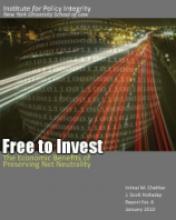
Fast, affordable Internet access for all.

Austin, Texas, with a little over 820,000 people, is home to several centers of higher ed, the Southwest Music Festival, and a next generation network known as the Greater Austin Area Telecommunications Network (GAATN).
It was also the second metro area selected by Google for the Google Fiber deployment. But before they got Google Fiber, a local partnership had already connected key community anchor institutions with limitless bandwidth over fiber networks. The network measures its success in terms of cost avoidance, and averages out to a savings of about $18 million per year combined for its 7 member entities.
In 2011, the National Association of Telecommunications Officers and Advisors (NATOA) named GAATN the Community Broadband Organization of the Year. Today, GAATN also serves the City of Austin, the Austin Indepedent School District (AISD), Travis County, local State of Texas facilities, Austin Community College (ACC), the University of Texas at Austin (UT), and the Lower Colorado River Authority (LCRA).
GAATN's bylaws prevent it from providing service to businesses or individual consumers. Texas, like 18 other states, maintains significant barriers that limit local public authority to build networks beyond simply connecting themselves. As a result, local entities must tread lightly even if they simply want to provide service for basic government functions.






In Tubes, journalist Andrew Blum goes on a journey inside the Internet's physical infrastructure to uncover the buildings and compounds where our data is stored and transmitted. Along the way, he documents the spaces where the Internet first started, and the people who've been working to make the Web what it is today.He was also just on C-Span's "The Communicators." I enjoyed the read and learned a few things along the way. Those looking for a dry, just-the-facts-ma'am approach may not enjoy the frequent musings of Blum on his experiences. But I did. One of his trips took him to a community in Oregon called The Dalles, where a municipal network allowed Google to build its very first "built-from-scratch data center." More on that in a post to come soon... Those who are doing their reading on tablets now will be interested to know that the eBook is temporarily priced at $1.99. The deal lasts until New Years according to the author.

In 2010, the Institute for Policy Integrity at the New York University School of Law released a report titled Free to Invest: The Economic Benefits of Preserving Net Neutrality. The report, authored by Inimai Chettiar and J. Scott Holladay, is a great resource - substantial and very digestible - on what net neutrality really is, how it is (or is not) regulated, and the economic possibilities policy makers must consider when moving ahead.
The Institute looks at the economic relationships between content providers, ISPs, and consumers. In addition to the current economic structure, the report examines possible alternate pricing models that are contrary to our current net neutrality policies. We have extracted just a few excerpts and encourage you to get the full report.
There are five main findings that are examined in depth:
Internet Market Failure: The report explains how ISPs lose potential dollars under today's market structure. There is ample motivation for them to find a way to charge content providers based on delivery, and open up a whole new market far beyond our net neutrality policy.
The FCC’s nondiscrimination rule would prohibit an ISP from treating any content, application, or service in a “discriminatory” manner, subject to reasonable network management. This clearly bans pure price discrimination (charging different content providers different prices to access their subscribers). The regulation also bans ISPs from offering content providers a “take it or leave it” offer on access to their users. For example, an ISP like Verizon could not charge a website of a company like The New York Times a certain price for access to its subscribers by threatening to block the website from its network and therefore from its Internet subscribers.
Smart Policy Can Help: The authors of the report stress how the Internet must be viewed as a two pronged market - infrastructure to deliver the content and the content itself - and how both are equally important. Effective policy must recognize the delicacy of that balance.